Walk around parts of downtown Seattle these days and things look almost like they did before COVID-19 kicked out the tourists and the office workers.
Pike Place Market and the waterfront are teeming with visitors, though many wear masks. Cruise ships are back in Elliott Bay. Bars around Pioneer Square are often loud with Sounders and Mariners fans, and hotel lobbies and meeting rooms have actual business travelers.
“This is the first time seeing my primary customers face to face,” says a masked but elated Chris Orr, a Marriott International executive from Florida who was at the Hyatt Regency Seattle last week attending the 500-person Maritz Global Events meeting, the largest downtown business meeting since March 2020. “It’s been great.”
Visitor numbers downtown are back up to 87% of what they were in August 2019, compared to just 60% in early May, according the latest data on domestic visitation from the Downtown Seattle Association (DSA). Downtown hotel occupancy is back up to 74% of 2019 levels, versus just 37% in May.
And when you factor in broader trends — rising attendance at the Seattle Art Museum and other cultural spaces, say, or upcoming shows at venues like the Moore Theater and Climate Pledge Arena, or the rebound in downtown’s residential population — downtown seems to be turning a corner on COVID, despite the slower-than-expected return of office workers.
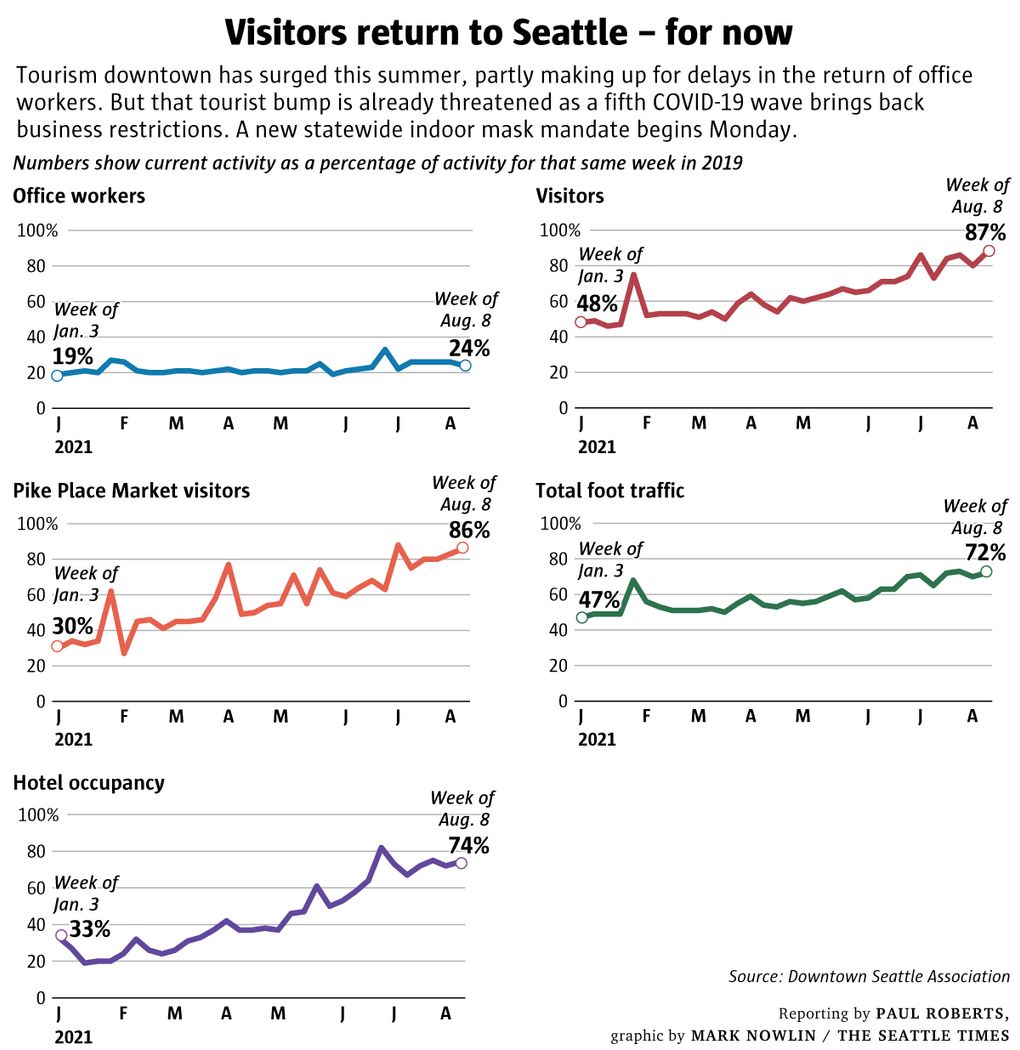
But look more closely and it’s clear that this welcome surge of out-of-towners has distinct limits.
Even before Gov. Jay Inslee reimposed an indoor mask mandate, which goes into effect Monday, and other restrictions Wednesday, downtown’s recovery momentum was hitting headwinds.
On Aug. 3, Garth Brooks halted ticket sales for a Sept. 4 concert at Lumen Field that had been announced only the week before, due to new concerns about the virus. And last week, rock shows scheduled to reopen both the Showbox and Paramount Theatre were postponed or rescheduled amid heightened COVID concerns.
Some downtown hotels have also reported dips in occupancy as well as cancellations of future bookings, says Tom Norwalk, CEO of the trade group Visit Seattle.
With the spread of the highly infectious delta variant, “there’s uncertainty and concern at all levels of travel right now — more so than we’ve seen in the last four to five months,” Norwalk says. “We’re really at kind of a quasi perilous time.”
Thanks to that uncertainty, many of downtown’s visitor-dependent businesses are back in a familiar limbo: scrambling to accommodate a jump in business (often while short-staffed) while bracing for new COVID-related restrictions or shutdowns.
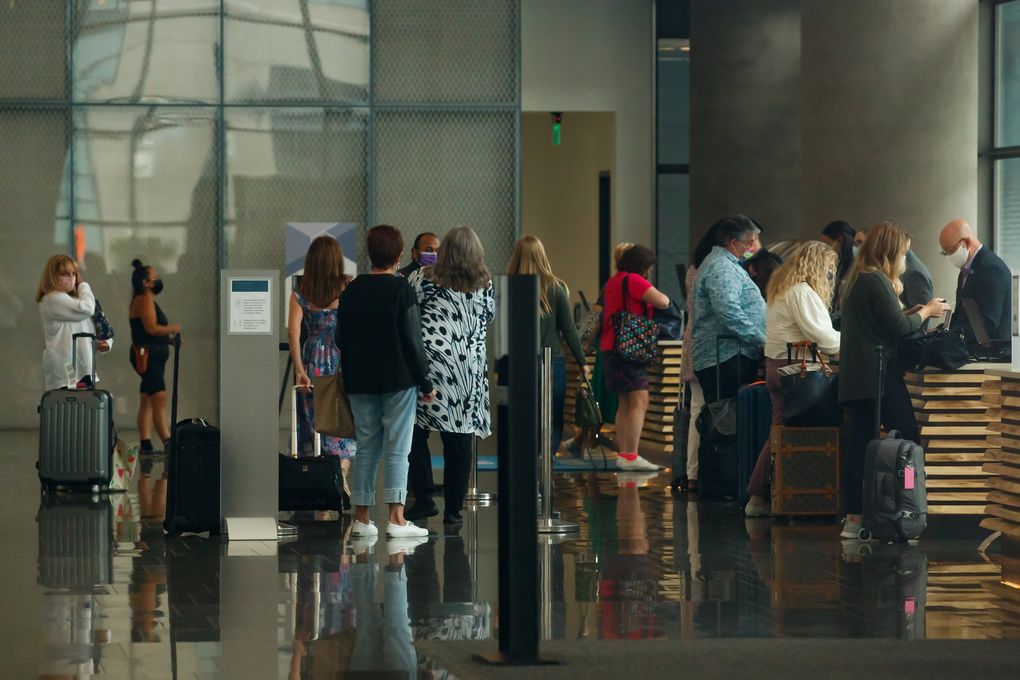
Huge stakes
For downtown Seattle and the region it supports, the implications of this uncertainty are enormous. In 2019, tourism, business travel and regional visits for local culture, sports and other attractions generated more than 80,000 jobs and nearly $12 billion in direct and indirect economic impact in the Seattle area, according to data compiled by Visit Seattle.
“If you just look at the [downtown] arts and cultural organizations … like the Seattle Art Museum, the 5th Avenue Theatre, Seattle Theatre Group, ACT and Town Hall, we bring in 2 million people on an annual basis into the downtown core,” says Bernie Griffin, manager director of the 5th Avenue Theatre.
Tourists and other visitors have become even more vital since the pandemic struck because downtown’s big economic driver — its 170,000 office workers — is still only partly back. The latest DSA data shows that the number of office workers based downtown who are actually working there is just 24% of 2019 levels, or roughly where it has been since last summer.
The crowds of summer visitors “in some ways buttress the lacking numbers on the office worker side,” says Jon Scholes, president and CEO of the Downtown Seattle Association.
Still, that buttressing effect comes with caveats.
First, this current tourist bounce, though much larger than last year’s, remains a shadow of its pre-pandemic self.
Canadian tourists, who accounted for one of every 10 pre-pandemic visitors to Seattle, are still largely absent, due to continued border restrictions.
Cruise ships are back — a welcome boost for many downtown retailers, especially in Pike Place Market. But thanks to an abbreviated season and fewer sailings, the 2021 season is expected to bring in just 227,000 passengers, or a fifth of the 2019 total, according to the Port of Seattle.
Visit Seattle reports 27 meetings booked at the Washington State Convention Center through June 2022 (starting with 17,000-attendee gaming industry event, PAX West 2021, over Labor Day weekend) and another 225 meetings at hotels and other venues. Yet that compares with 76 convention center events and 457 other meetings that were canceled for 2020 and 2021.
Lower demand, meanwhile, often means vendors must charge lower prices.
Downtown hotels, for example, are averaging less revenue per room booked: $206 as of Aug. 8 vs. $267 a year ago, according to Visit Seattle. The more telling metric, average revenue per available room, which captures overall financial performance, has fallen even farther: $136 now vs. $241 two years ago.
Before the pandemic, “people used to buy a whole fish … now, people are, you know, grabbing snacks,” says fishmonger Josh Frank Harvey at City Fish in Pike Place. “We want people to spend $500 on fish. Right now, I’m doing, like, $3 oyster shooters.”
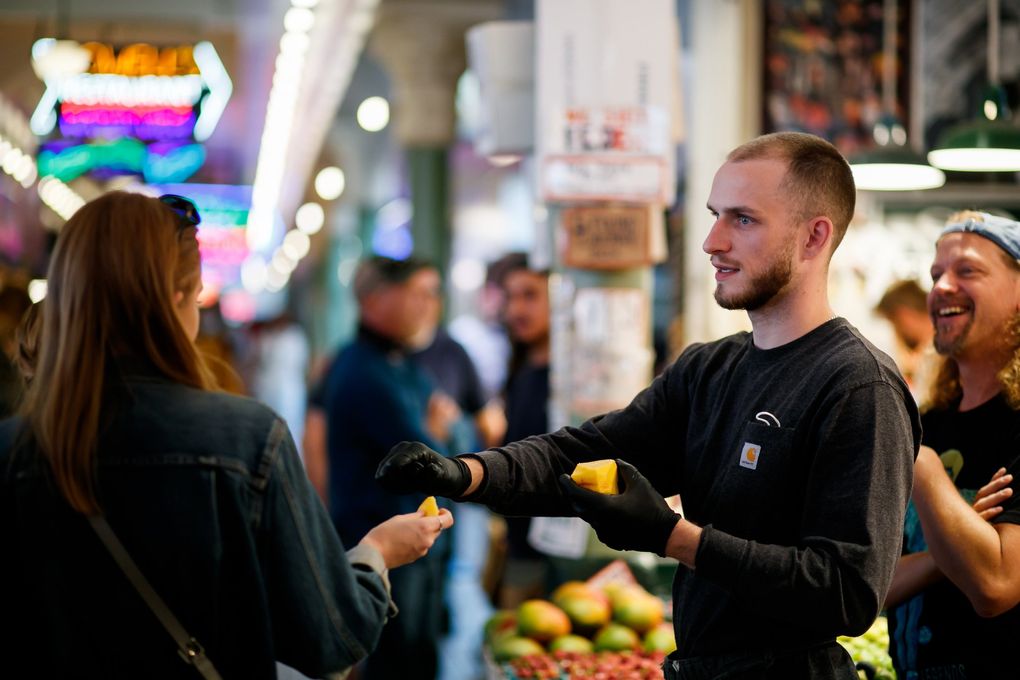
Other roadblocks to recovery
Like many downtown businesses, those that depend on visitors worry about the effects of the city’s homelessness crisis, and with some reason.
Carmel, California, resident Jarilyn Russo, who was back in Seattle for the first time since 1997, says she was surprised by the number of homeless people downtown. “It’s very similar to the San Francisco’s homeless situation,” says Russo as she stood with her family near the market.
A few blocks away, near the McDonald’s on Third Avenue, Sound Transit security officer Andrés Ramirez-Albanes says he and his partner were approached by a couple from Ohio “telling us that they wanted to stand near us because they were scared of, like, everything that was going on.”
Still, for many visitor-dependent businesses and organizations, the bigger risk to recovery is COVID, in part because it’s so unpredictable.
Many tourist-focused retailers and restaurants are now trying to anticipate how much inventory and staff they’ll need over the next few weeks and months as they face both the normal end-of-summer slowdown and any new COVID-related restrictions.
Many performance venues are considering whether to continue booking future acts and when and how to start rehearsals.
The 5th Avenue Theatre, which has already downsized its coming season by 25%, to 15,000 subscribers, plans to start rehearsals for the opening show — “Beauty and the Beast,” in January — in mid to late October, says Griffin. But depending on how COVID cases counts go, “We may be, you know, using a more hybrid method of rehearsal,” she adds. “We were starting to see around the curve — and then the curve changed direction a little bit.”
Likewise, planners of conventions and business meetings already booked for Seattle venues must decide whether to move ahead or postpone or cancel once again. “A lot of those decisions are being made right now, day to day,” says Norwalk.
“We’re just really hoping that we don’t find ourselves going backwards 12 months and all of a sudden groups deciding, ‘You know what? We’re going to take another year off. Let’s wait until we get this under control.’” Norwalk says. “That would have just a devastating effect to our city and our downtown.”
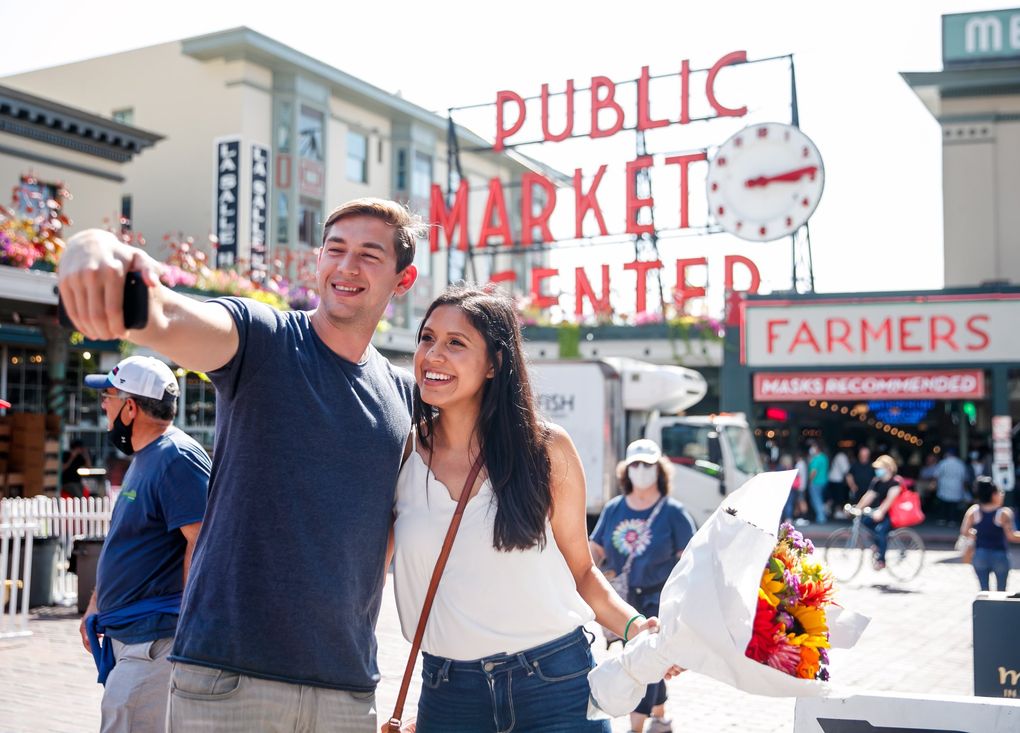
Many local businesses, venues and organizations have mandated or are considering proactive measures such as mask and vaccine mandates for customers — a plausible move in a city with a 78% vaccination rate for residents 12 and over.
But not every visitor-dependent business in downtown Seattle has that option. To the contrary, many remain vulnerable to actions and attitudes of customers who may be coming from places where such precautions aren’t required or as accepted.
“We been wildly successful here [with vaccinations] but that’s not necessarily the case around the country — and many of those are key markets … where we want people to visit from,” Norwalk says.
That underscores the pandemic paradox inherent to a visitor-led recovery: Many of these businesses depend on the sort of busy social scenes that, absent precautions, may help drive up infections and lead to more restrictions.
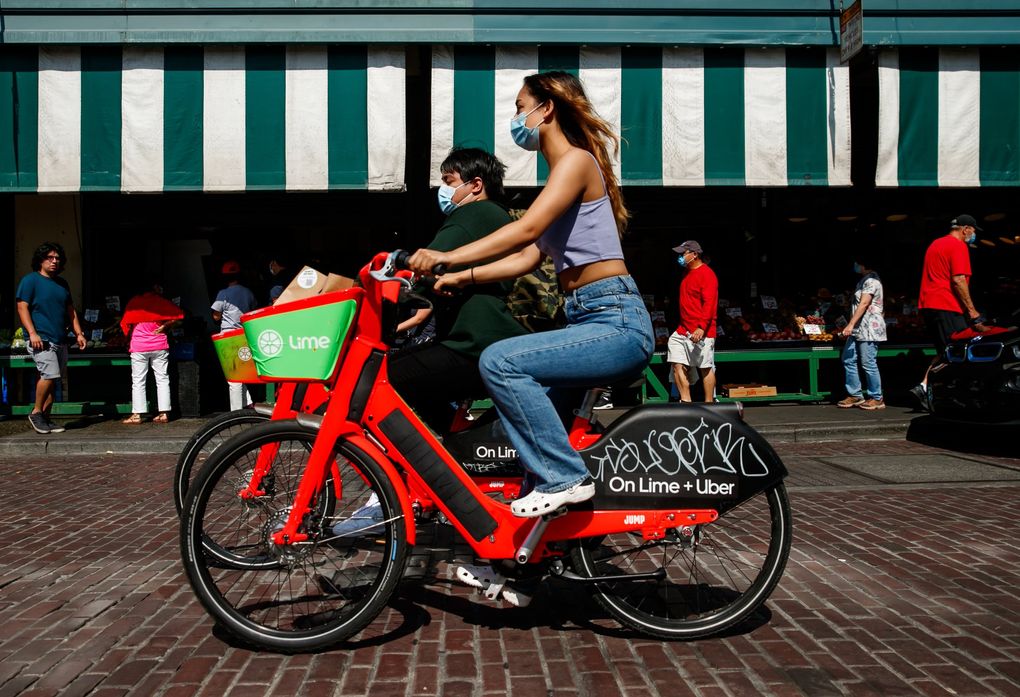
Keeping calm and carrying on
To protect the downtown’s fragile recovery, city and county governments and business groups have launched marketing campaigns and other initiatives to help visitor-dependent businesses. Funds from federal pandemic programs have also helped.
But those efforts are outmatched by the scale and unpredictability of the threat from COVID. With so much of the business environment out of their control, many tourist-dependent vendors and organizations are simply continuing with the strategies of adaptation and flexibility they’ve adopted during the pandemic.
City Fish, for example, has stayed afloat in large part by shipping more fish to out-of-town customers and depending less on the market. “I’m not doing the big, giant displays,” says Harvey. “I’m not doing the show. I mean, I’m here by myself.”
Other vendors say their biggest advantage is experience: After 18 months of COVID surges, restrictions, and the absence and return of customers, many feel they’ve faced most of what the pandemic can throw at a business.
“I’ve seen a couple different phases of this [and] I think people will continue to shop,” says Sam Kallaway, sales lead at Sosio’s Fruit and Produce in Pike Place Market.
While the pandemic has been hard, Kallaway says, it has also left him feeling more resilient. “We’re calloused a little bit,” he says. “At this point, like, I’m ready for whatever comes next.”
